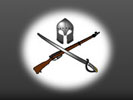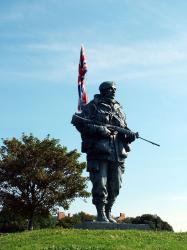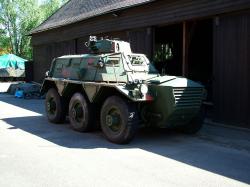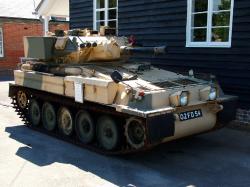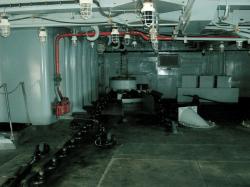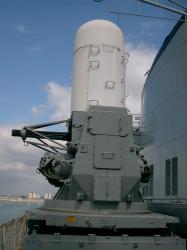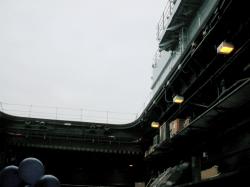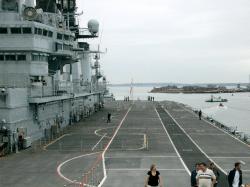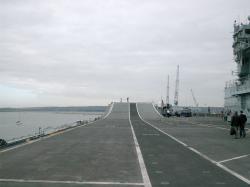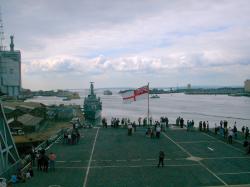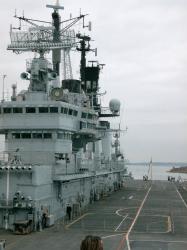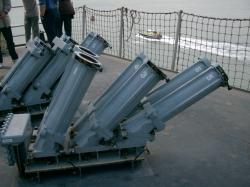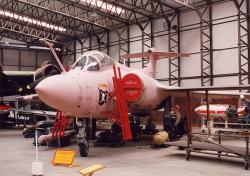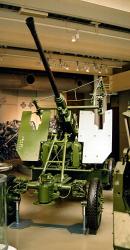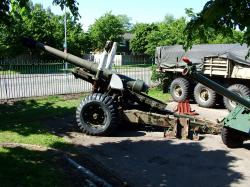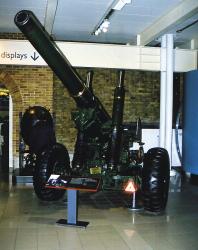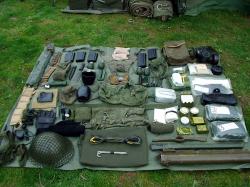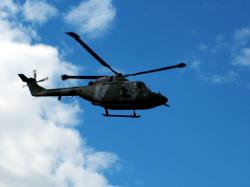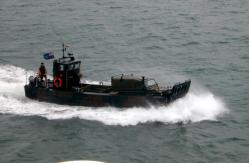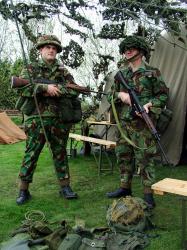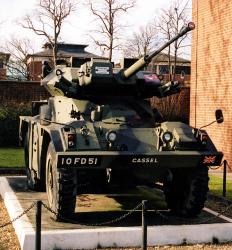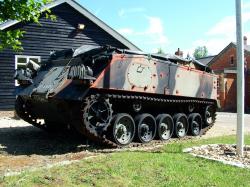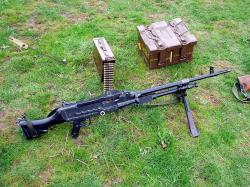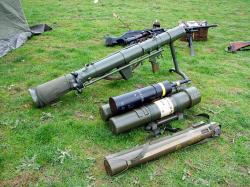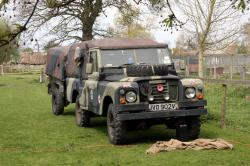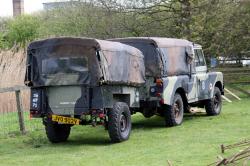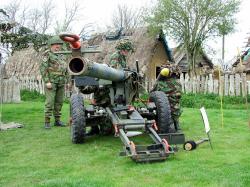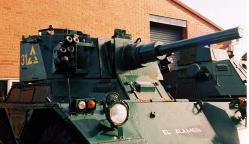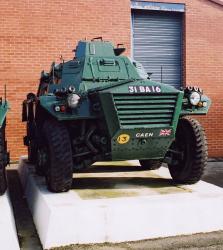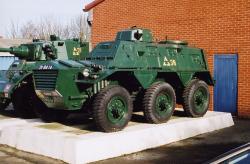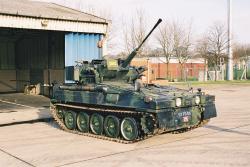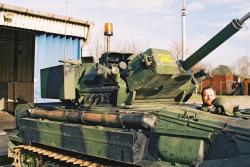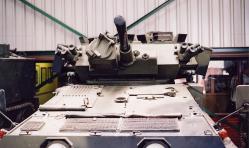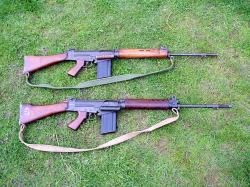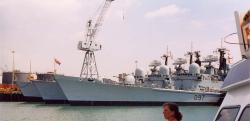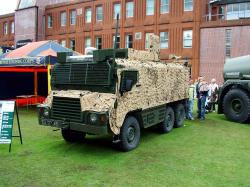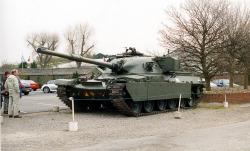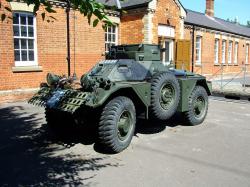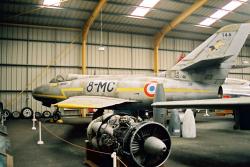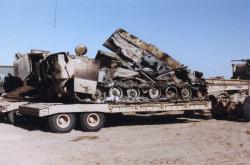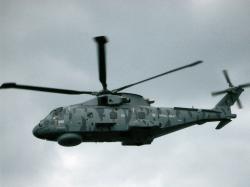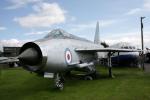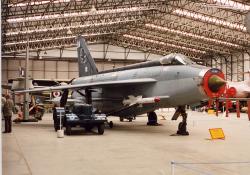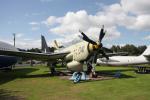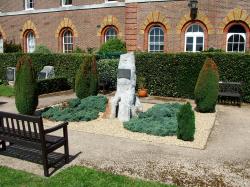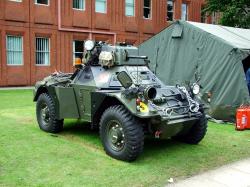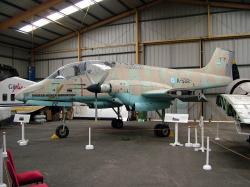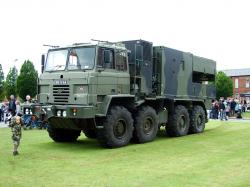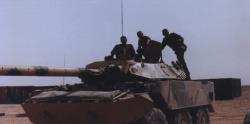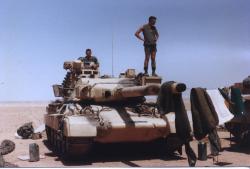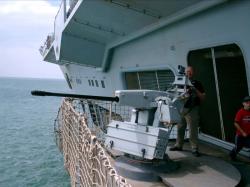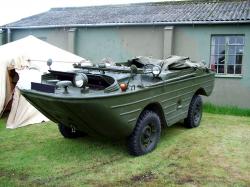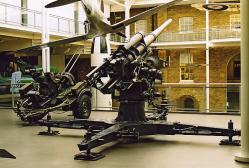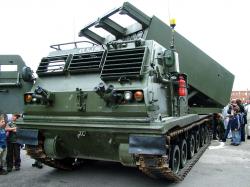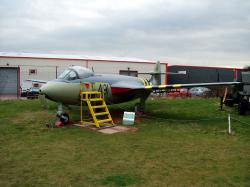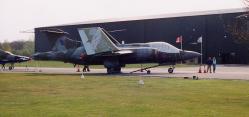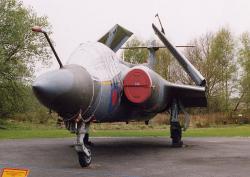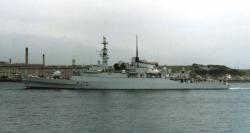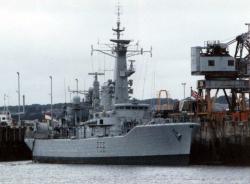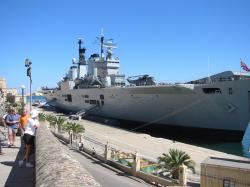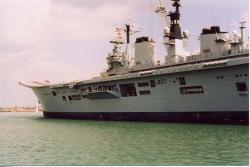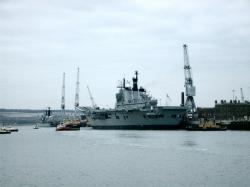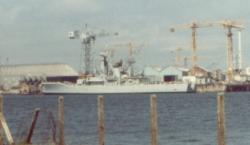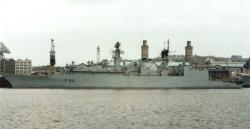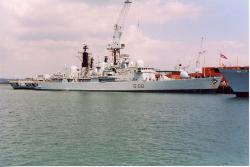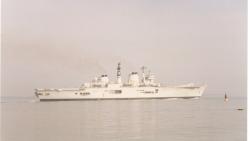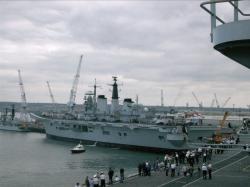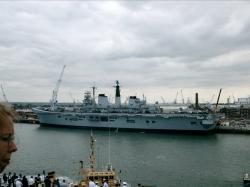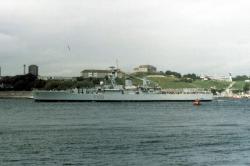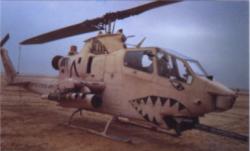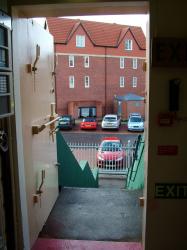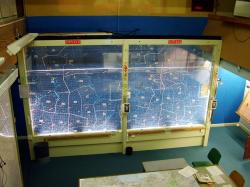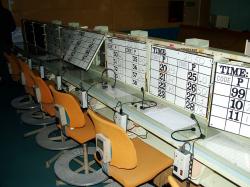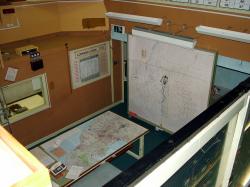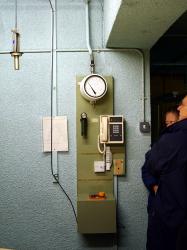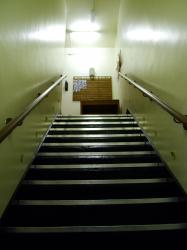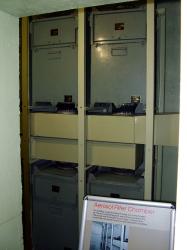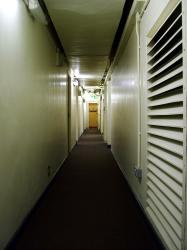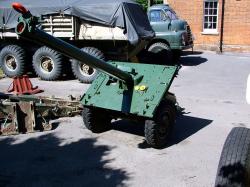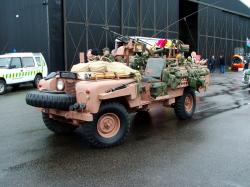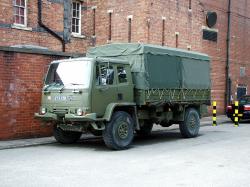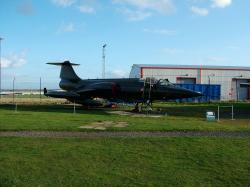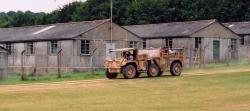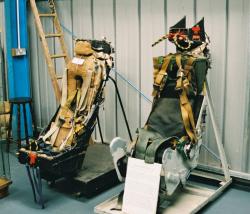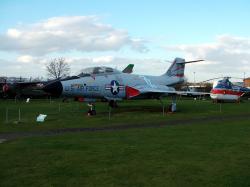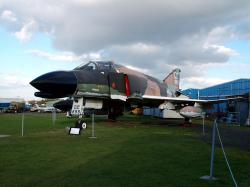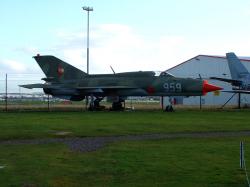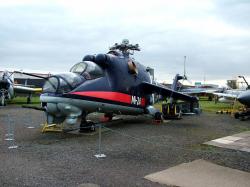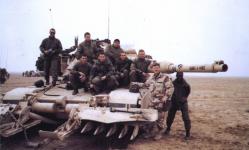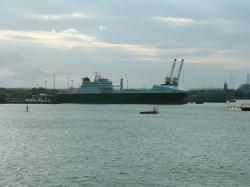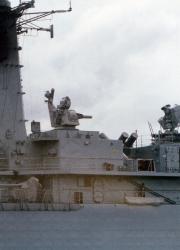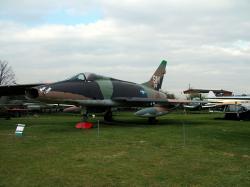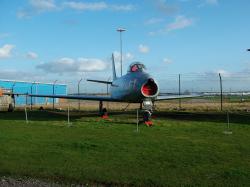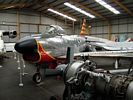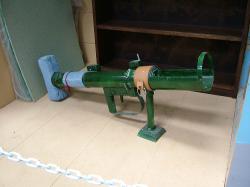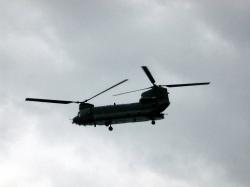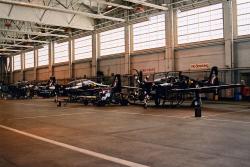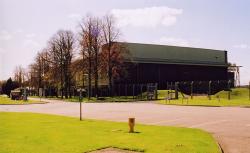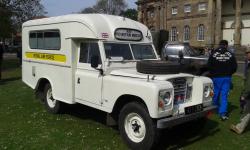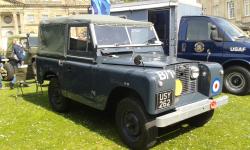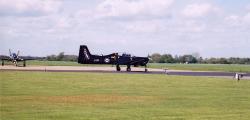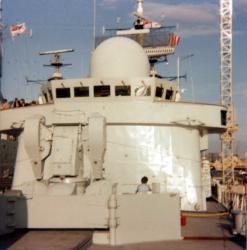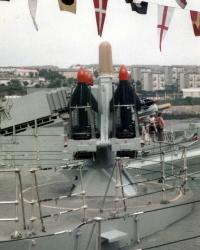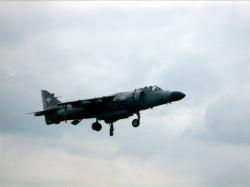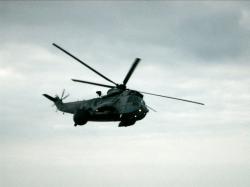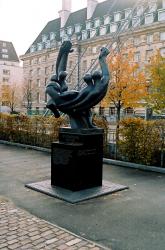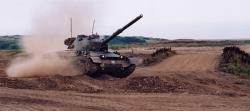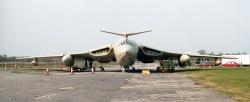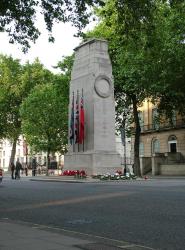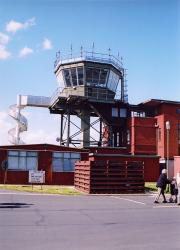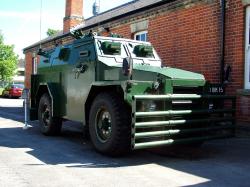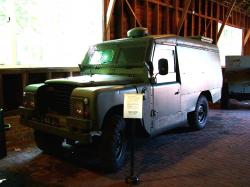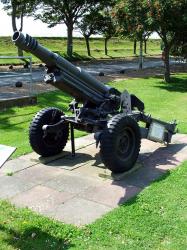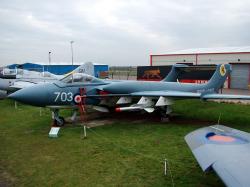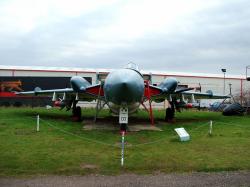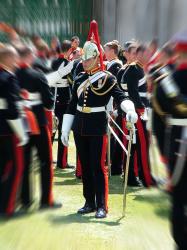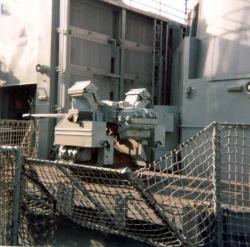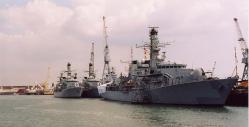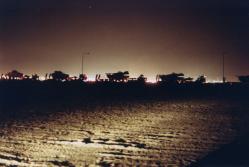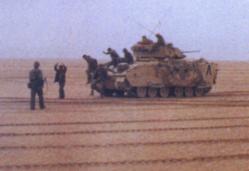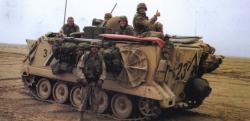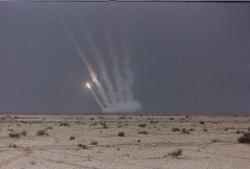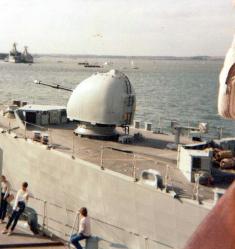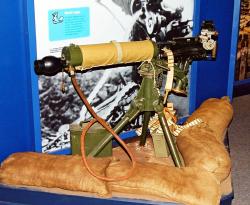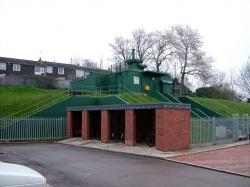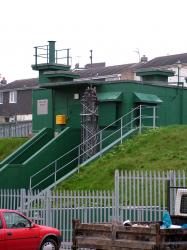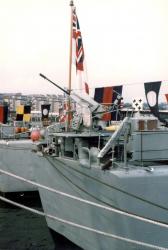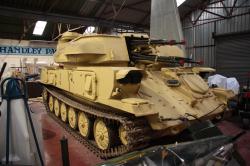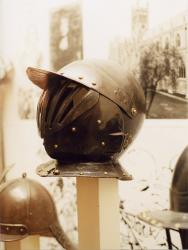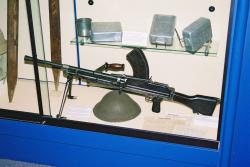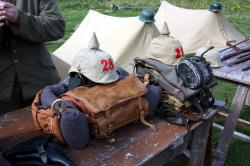Translate this Page
Recent images :
- International Harvester M5 halftrack
- Dassault Mystère Mk IVa number 146
- Ark Royal, Anti-ship missile defence gun.
- RAF Series 2 Land Rover
- Lightweight, air portable Land Rover
- Daimler Ferret Mk 1/2 Armoured Car
- RAF Mountain Rescue Series 3 Land Rover
- French Bronze 6 pounder cannon
- Farsley South African War Memorial
- Farsley War memorial
Images relating to the Later 20th Century & Modern Military
Click on the entry for a larger image and details, or click to go back to the previous index
The statue outside the former Royal Marines Eastney barracks near Portsmouth dedicated to those who fought in the Falklands War 1982. It is based on an iconic photograph of a Marine 'yomping' or travelling cross-country from the landing point in San ...
Royal Marines Museum, Eastney, Southsea nr Portsmouth, England. 2007
Two depictions of the kind of living quarters that soldiers would have had in two periods in Aldershot's life. One shows the barracks during the Victorian period, the other during the 1950's.
Aldershot Military Museum, Hampshire, England, May 2007
Protected by aluminium armour and mounting a 76mm main gun.
Aldershot Military Museum, Hampshire, England, May 2007
The cable locker, and anchor chains on board the Ark Royal
Portsmouth Naval Dockyard, July 2003
The Raytheon Systems, Phalanx Close In Weapons System was first developed in 1977, and began to be deployed in the US Navy from 1980. It fires 20mm shells and can be operated fully automatically using both radar and Forward-looking Infra-Red (FLIR) t...
Portsmouth Naval Dockyard, July 2003
A view from below decks, looking up through one of the aircraft lifts
Portsmouth Naval Dockyard, July 2003
Taken from the 'ski-jump' the view of the flight-deck and stern gives some impression of the ship's size.
Portsmouth Naval Dockyard, July 2003
This view of Ark Royal's flight deck clearly shows the take-off route for the ship's complement of Sea Harrier FA.2 aircraft. The 'ski-jump' at the end provides a boost of much-needed lift at the last moment.
Portsmouth Naval Dockyard, July 2003
The stern and white ensign of the Ark Royal, with the older Type 23 'Duke' class frigate, HMS Westminster moored astern, and the harbour entrance in the background.
Portsmouth Naval Dockyard, July 2003
The superstructure, bridge and masts of the Ark Royal.
Portsmouth Naval Dockyard, July 2003
One of the chaff dispensers on board the Ark Royal, designed to eject huge quantities of aluminium foil in a cloud to confuse a radar-guided missile attack.
Portsmouth Naval Dockyard, July 2003
Midlands Aircraft Museum, Coventry Airport, Baginton,England. March '07 & March '08
This Buccaneer 'XX901' served with the RAF in the 1st Gulf War, 1991, and is pictured here in those colours.
Yorkshire Air Museum, Elvington, York, England. Easter 2003
The 40mm L/60 automatic anti-aircraft gun was designed in Sweden by Bofors in 1928. It became so successful it was simply known as a 'Bofors gun' and in various guises has been used by many armed forces up to the present. This particular example date...
Imperial War Museum, London, England. October 2003.
A de-activated example of the ubiquitous British 1,000lb bomb carried by most of the RAF's ground-attack aircraft and although not sophisticated, effective and cheap.
North East Aircraft Museum, Sunderland, England. October 2004.
A medium cailbre artillery piece brought into service in 1941 (this one dates from 1942) was still being used in the 1970's. It could fire a 45.4 kg shell up to a range of 14,810 metres or more than 9.2 miles.
Imperial War Museum, London, England. October 2003.
A display of the equipment as carried by the soldiers and marines who fought in the Falklands War, 1982.
It includes all his webing, spare clothing, bergen, washing & cleaning gear, rations & cooking equipment, sleeping bag, NBC suit plus respirat...
History at Murton - Murton Park, York, England. April 2008
The army's primary battlefield utility helicopter seen here with the improved rotor tips.
Army in Yorkshire event, Imphal Barracks, York, UK. July 2008
This LCVP (Landing Craft Vehicle Personnel), from 17 Royal Logistics Corps Port and Maritime Regiment can transport a platoon of Soldiers or, as in this case, a Landrover and trailer and deliver them to a landing beach via the bow ramp.
Portsmouth Naval Dockyard, July 2003
A selection of re-enactors representing the British Army of the Rhine during the 1970's. They are dressed and equiped for the period in British DPM camouflage, '58 pattern webbing, puttees around the boots, and SLR L1A1 rifles (with the earlier woode...
History at Murton - Murton Park, York, England. April 2008
An image of a Fox Combat Vehicle, Reconnaissance (Wheeled) or CVR(W) formerly in service with the Queens Own Yeomanry, a British Territorial Army or volunteer regiment but now serving as a gate guardian. It was equipped with a 30mm Rarden gun in it's...
Yorkshire Squadron, The Queens Own Yeomanry, Fulford Barracks, York. Feb' 2004
An image of a Fox Combat Vehicle, Reconnaissance (Wheeled) or CVR(W) formerly in service with the Queens Own Yeomanry, a British Territorial Army or volunteer regiment but now serving as a gate guardian. It was equipped with a 30mm Rarden gun in it's...
Yorkshire Squadron, The Queens Own Yeomanry, Fulford Barracks, York. Feb' 2004
The main light machine gun used by the British army since the 1960's. A 7.62mm, belt-fed workhorse that can lay down a heavy supporting fire from an infantry platoon or mounted on vehicles.
Displayed by the Forces80 re-enactment group.
History at Murton - Murton Park, York, England. April 2008
A display of 2 light anti-armour weapons used by the British Army in the 1970's and 80's.
The larger of the two is the Carl-Gustav 84mm recoilless rifle shown sitting on it's bipod mount. Also shown are examples of it's armour-piercing rounds.
...
History at Murton - Murton Park, York, England. April 2008
The classic British 4x4 of the 1970s with Sankey trailor
History at Murton 3 - Murton Park, York, England. April 2009
The classic British 4x4 of the 1970s with Sankey trailor
History at Murton 3 - Murton Park, York, England. April 2009
An artillery piece looked after by members of the 20th Century Revisited group. It was a prominent infantry fire support weapon from the 1960's.
It was a 120mm recoilless rifle and had a range of between 800 and 1000 yards. It fired a HESH round w...
History at Murton - Murton Park, York, England. April 2008
A re-creation of a crew of British Army personnel working a Mobat recoilless anti-tank weapon of the 1970's.
Crew'ed by members of the 20th Century Revisited group.
History at Murton - Murton Park, York, England. April 2008
This 6 wheel drive armoured car was produced by Alvis Ltd during the 1960's and served with British forces into the 1970's. It had a top speed of 45mph (72km/h) but had good cross-country performance from it 6 wheel design and could function capably ...
Yorkshire Squadron, The Queens Own Yeomanry, Fulford Barracks, York. Feb' 2004
This 6 wheel drive armoured car was produced by Alvis Ltd during the 1960's and served with British forces into the 1970's. It had a top speed of 45mph (72km/h) but had good cross-country performance from it 6 wheel design and could function capably ...
Yorkshire Squadron, The Queens Own Yeomanry, Fulford Barracks, York. Feb' 2004
Built on the same basic chassis as the Saladin Armoured Car (see entry), this 6 wheel drive APC was designed in 1952 and has served with the British army until the 1990's, latterly in an urban role in Northern Ireland, and with many other countries u...
Yorkshire Squadron, The Queens Own Yeomanry, Fulford Barracks, York. Feb' 2004
Built on the same basic chassis as the Saladin Armoured Car (see entry), this 6 wheel drive APC was designed in 1952 and has served with the British army until the 1990's, latterly in an urban role in Northern Ireland, and with many other countries u...
Yorkshire Squadron, The Queens Own Yeomanry, Fulford Barracks, York. Feb' 2004
The current vehicle used by the Queens Own Yeomanry, although this particular vehicle is on loan from the Guards, the Scimitar is a variant of the Scorpion class of Combat Vehicle, Reconaissance (Tracked) mounting a 30mm Rarden Cannon for defence rat...
Yorkshire Squadron, The Queens Own Yeomanry, Fulford Barracks, York. Feb' 2004
A close-up view of the turret of the Scimitar (see other entry for details) showing the targeting equipment and smoke grenade launchers, as well as the exhaust for the new Cummins powerplant and the side stowage containers just above the tracks.
Yorkshire Squadron, The Queens Own Yeomanry, Fulford Barracks, York. Feb' 2004
This head-on view of the British Scorpion light tank or Combat Vehicle, Reconnaissance (Tracked) shows clearly it's sloped aluminium armour and 76mm main gun. It has a crew of 3 and with it's original Jaguar engine could reach 55mph.
The Muckleburgh Collection, Norfolk, England, Summer 2003.
A pair of British SLR rifles as used by the British Army during the 1970's and 80's.
They were a 7.62mm semi-automatic, single shot version of the Belgian FN Assault rifle.
Displayed by the 20th Century Revisited group.
History at Murton - Murton Park, York, England. April 2008
British Type 42 destroyers, HMS Edinburgh (foreground), York & Manchester.
Portsmouth harbour, August 2002.
A new vehicle entering service with the British Army as a patrol vehicle and convoy escort. It has better armour and protection than a snatch landrover but is more manouverable and less intimidating than a tracked APC. The photographer was also told ...
Army in Yorkshire event, Imphal Barracks, York, UK. July 2008
An unusual prototype of this British battle tank of the 1960's mounting a 120mm gun
Yorkshire Air Museum, Elvington, York, England. Easter 2003
In Middle East desert colour scheme.
Yorkshire MVT event, York, April 2017
French fighter-bomber of the 1950's up the the 1970's
Midlands Aircraft Museum, Coventry Airport, Baginton,England. March '07 & March '08
The Mystère first flew on 28th Sept 1952, and more than 480 of these single-seat fighter-bombers flew with the French, Indian and Israeli Air Forces in the 1950's and 60's. They were armed with 2 x 30mm DEFA cannons, rockets in an under-fuselage pac...
North East Aircraft Museum, Sunderland, England. Spring 2004.
The wreckage of two US Bradley AFV's of the 2nd Armoured Cavalry Regiment, knocked out during operation Desert Storm, in the 1st Coalition's war against Iraq to liberate Kuwait.
The Iraq/Kuwait desert, 1991
An Augusta Westland EH101, in service with the Royal Naval Air Service as a Merlin HM.1 No. R269. It's primary roles are anti-submarine and Anti-surface warfare, but can also be used in the Airborne early warning, Search and Rescue, Medevac and trans...
Portsmouth Naval Dockyard, July 2003
The classic lines of the British Lightning interceptor, which was in use across the world from the late 1950's into the 1980's. It's 'party piece' was to stand on it's tail almost from take-off and climb vertically to it's operational height and coul...
Dumfries and Galloway Aviation Museum, August 2010
This Lightning, 'XS903' was built in 1966 and flew with No. 5 Sqn at RAF Binbrook and Akrotiri, Cyprus and with 11 Sqn at Coningsby until 1987.
Yorkshire Air Museum, Elvington, York, England. Easter 2003
The airborne early warning radar aircraft used by the Royal Navy's Fleet Air Arm during the 1960's. It's highly distinctive shape includes novel coaxial contra-rotating propellers, double folding wings and the bulbous radar housing on the underside.
Dumfries and Galloway Aviation Museum, August 2010
A memorial to the Royal Marines who fell in the Falklands War 1982 presented by the people of the Falklands themselves. It is situated outside the former Marine Barracks in the memorial gardens and the inscription reads:
"These stones come trom th...
Royal Marines Museum, Eastney, Southsea nr Portsmouth, England. 2007
A lovely example of the Mark 2 Ferret displayed at the Imphal open day. Used in the 1960's, this one mounts a .30 calibre Browning MG.
Army in Yorkshire event, Imphal Barracks, York, UK. July 2008
The Pucara is a ground support and counter-insurgency aircraft used in various airforces around the world, most notably by the Argentinian Air Force during the Falklands War. There it was also found to be effective against hellicopters but vulnerable...
North East Aircraft Museum, Sunderland, England. October 2004.
The Foden based Improved Medium Mobility Load Carrier mounting the Cobra radar array as used by the British Army for counter battery artillery location.
Army in Yorkshire event, Imphal Barracks, York, UK. July 2008
An AMX 10 Light Tank of the French Foreign Legion, probably the 1st REC, as part of the Coalition forces against the Iraqi invasion of Kuwait. Note that this useful item of light armour is wheeled, rather than tracked for speed and durability on roa...
Iraqi/Kuwait desert, 1991
An AMX 30, crewed by French Foreign Legionaires showing the human side of war. Even in war, kit and equipment needs to be maintained, and gun barrels can double as good clothes lines. It is armed with a French-made 105mm main gun, and a 20mm GIAT can...
Iraqi/Kuwait desert, 1991
Based on the Oerlikon 20mm cannon, the GAM BO1 is fitted to most ships of the Royal Navy for smaller-caliber gunnery duties. It has a range of 2km and a rate of fire up to 900 rounds per minute.
Portsmouth Naval Dockyard, July 2003
The GAZ 46 was inspired by US amphibious vehicles supplied to Russia during the War, but entered service in the 1950's an has been used by many easter-bloc allied forces since. It could carry up to 5 people, and due to it's steeply raked front and re...
The Wheels and Wings 2006 event, Yorkshire Air Museum, York, UK. May 2006.
The premier, multi-purpose gun of the second world war, the German 88 was respected and feared wherever it was encountered. A high muzzle velocity, good accuracy and penetrating ammunition, as well as plentiful production meant that this AA gun could...
Imperial War Museum, London, England. October 2003.
The first twin engined delta-winged jet, the Javelin saw sevice with the RAF from 1956-68. An impressive all-weather fighter, nearly 400 were built, although this Mk 5 is thought to be the only one remaining of it's type.
Midlands Aircraft Museum, Coventry Airport, Baginton,England. March '07 & March '08
The Royal Artillery's main long range weapon system capable of launching 12 guided rockets, each delivering a 200lb warhead up to 300 miles range.
Army in Yorkshire event, Imphal Barracks, York, UK. July 2008
First introduced in the early 1950's and still serving with various airforces around the world right into the 1990's, the Hunter has been described as Britain's most successful post-war military aircraft. It was also the last in a line of classic fig...
North East Aircraft Museum, Sunderland, England. October 2004.
This aircraft served with the Royal Navy and is painted in the Suez Invasion colour scheme from 1956.
Midlands Aircraft Museum, Coventry Airport, Baginton,England. March '07 & March '08
This 2-seat low-level strike aircraft 'XN974' was the first production S2 and made its maiden flight on 5th June 1964. It served with the Fleet Air Arm on board the carrier HMS Eagle, then became an avionics development aircraft with British Aerospac...
Yorkshire Air Museum, Elvington, York, England. Easter 2003
This 2-seat low-level strike aircraft 'XN974' was the first production S2 and made its maiden flight on 5th June 1964. It served with the Fleet Air Arm on board the carrier HMS Eagle, then became an avionics development aircraft with British Aerospac...
Yorkshire Air Museum, Elvington, York, England. Easter 2003
An Amazon Class [Type 21] Frigate sunk in the Falklands Campaign. Built. 1975 by Vosper Thornycroft to a commercial design and subsequently bought by the Royal Navy. Displacement. 3250 tons Dimensions. 117m x 13m x 6m. Speed. 34 knots Complement. 1...
Photographed Plymouth 1980.
A Leander class [Exocet conversion] Frigate Built 1967 by Hawthorn Leslie. Displacement 2,860tons Dimensions 113m x 12m x 5m. Speed 27 knots. Complement 230.
Armament 4 Exocet missiles, 3 Sea Cat Missile systems, 2 x 40 mm guns, 6 torpedo tubes, 1 ...
location and date unknown
The carrier Ark Royal during a visit to Malta (courtesy of J. Williamson)
Valeta harbour, Malta. October 2002.
Several views of the Carrier HMS Ark Royal, moored in Portsmouth harbour, photographed from the regular fleet boat tours run from the Historic Docks.
Portsmouth harbour, August 2002.
Ark Royal, moored alongside the Portsmouth dockyard.
Portsmouth Naval Dockyard, July 2003
One of Great Britain's last big carriers, the previous Ark Royal was laid down in May 1943, launched May 1950 but was not completed until 1956 to revised/modernised plans. Displacement 45,000 tons, Dimensions 804 feet x 135 feet x 33 feet, Speed 31 k...
Photographed Plymouth 1980.
Leander Class Frigate H.M.S. Bacchante, built in 1969 by Vickers. Disposed of 1983. Armament : Twin 4.5"" guns, 2 x 20 mm, 1 Sea cat missle system, 1 Mark 10 mortar. This vessel was disposed of by the Royal Navay and shortly thereafter commissioned i...
Not known
Type 22 Frigate [Batch 2]. Built 1985 by Yarrow. Displacement 4100tons Dimensions 143m x 15m x 6m. Speed 30 knots. Complement 290.
Armament 4 Exocet missiles, 2 Sea Wolf Missile systems, 2 x 40 mm and 2 x 20mm guns, 6 torpedo tubes, 2 Lynx helicopt...
Location unknown, 1980's
D88, HMS Glasgow (type 42 destroyer) with Victory in the background.
Portsmouth harbour, August 2002.
The carrier Illustrious returning from Middle East deployment
the Solent. 25th March 2002.
HMS Invincible moored alongside the Portsmouth quayside. The first of the Invincible class light carriers, she saw service as the flagship in the Falklands war 1982.
Portsmouth Naval Dockyard, July 2003
HMS Invincible moored alongside the Portsmouth quayside. The first of the Invincible class light carriers, she saw service as the flagship in the Falklands war 1982.
Portsmouth Naval Dockyard, July 2003
Name ship of the Leander class of Frigates. Converted to carry Ikara Anti-Submarine Missile System [1973-76] Built 1963 by Harland and Wolf. Displacement 2,860tons Dimensions 113m x 12m x 5m. Speed 29 knots. Complement 240.
Armament Ikara Anti-Su...
Photographed Plymouth 1980.
The latest British assault carrier HMS Ocean (L12) in dock
Portsmouth harbour, August 2002.
The Type 23 Frigate Westminster, moored in Portsmouth during an Assisted Maintenance Period. Her 4.5 inch Mk 8 gun with 2 quad Harpoon missile launchers just aft can clearly be seen.
Portsmouth Naval Dockyard, July 2003
A Cobra attack helicopter of the 4th squadron, 2nd Armoured Cavalry.
Kuwait/Iraqi desert, 1991
Views from a tour around the York Cold War Bunker
Acomb, near York, UK. Feb 2007
Views from a tour around the York Cold War Bunker
Acomb, near York, UK. Feb 2007
Views from a tour around the York Cold War Bunker
Acomb, near York, UK. Feb 2007
Views from a tour around the York Cold War Bunker
Acomb, near York, UK. Feb 2007
Views from a tour around the York Cold War Bunker
Acomb, near York, UK. Feb 2007
Views from a tour around the York Cold War Bunker
Acomb, near York, UK. Feb 2007
Views from a tour around the York Cold War Bunker
Acomb, near York, UK. Feb 2007
Views from a tour around the York Cold War Bunker
Acomb, near York, UK. Feb 2007
Views from a tour around the York Cold War Bunker
Acomb, near York, UK. Feb 2007
Views from a tour around the York Cold War Bunker
Acomb, near York, UK. Feb 2007
Aldershot Military Museum, Hampshire, England, May 2007
An excellent example of the 'Pink Panther' style Land Rover as used by the SAS for desert reconnaissance and special operations. The superstructure has been pared to the bone, then covered in equipment!
The close-ups show the sort of kit carried, ...
The Wheels and Wings 2006 event, Yorkshire Air Museum, York, UK. May 2006.
This image shows several objects used by the Manchester's Regiment during the Malaysia campaign 1951-54. The main item is a specially designed Lee Enfield Carbine, 5 inches shorter than the standard rifle to be more effective in jungle warfare. It is...
The Museum of Manchester's Regiment, Ashton-under-Lyne, UK. March 2004
The army's current 'workhorse' 4 ton truck.
Army in Yorkshire event, Imphal Barracks, York, UK. July 2008
A clean example showing radio aerial mountings
Yorkshire MVT event, York, April 2017
Although not popular with the USAF, the F104 (in it's C variant) flew in Vietnam in 1965. It saw most service, however, with European air forces in it's G variant. This example with it's distinctive dark colour scheme flew in the Royal Danish Airforc...
Midlands Aircraft Museum, Coventry Airport, Baginton,England. March '07 & March '08
Developed during WW2 as a replacement for the out-gunned Stuart Light Tanks, it was designed ito carry a heavier 75mm gun to take on the German armour. Although it actually saw little service other than the the later stages of the war in NW Europe, i...
The Wheels and Wings 2006 event, Yorkshire Air Museum, York, UK. May 2006.
An unusual 6 wheel drive, roll-articulated vehicle designed in the US in the 1970's as an all-terrain transport. It is fully amphibious, and the joint in the middle allows the front and rear halves to pitch and roll up to around 40 degrees from each ...
The Muckleburgh Collection, Norfolk, England, Summer 2003.
An essential piece of kit in any modern military aircraft, this image shows a pair of Martin-Baker ejector seats, the likes of which have saved many an aircrews' life since their invention in the mid 1940's. The seat on the left was fitted in an RAF ...
North East Aircraft Museum, Sunderland, England. Spring 2004.
Another iconic 1960's US fighter/interceptor which served with distinction in the photo-reconnaisance role into the 1980's. This example is painted in the 60th Fighter Interceptor Squadron USAF.
Midlands Aircraft Museum, Coventry Airport, Baginton,England. March '07 & March '08
One of the most successful fighter aircraft of the latter 20th Century, the F4 saw service with many airforces across the world including the RAF and the Royal Navy as well as many other European, Middle Eastern and Far Eastern Airforces. It saw acti...
Midlands Aircraft Museum, Coventry Airport, Baginton,England. March '07 & March '08
The classic fighter-bomber of the Soviet Cold-War days, this example served with the East German Army Air Force fro 1968 until the late 1980's
Midlands Aircraft Museum, Coventry Airport, Baginton,England. March '07 & March '08
This impressive Russian combat helicopter has served with 30 countries and saw particular service in Afganistan during the Russian Occupation. This example was bought by BAe Systems and is on loan to the Midlands Aircraft Museum from them, hence the ...
Midlands Aircraft Museum, Coventry Airport, Baginton,England. March '07 & March '08
A good shot of a specialist mine clearance tank of the 2nd Armoured Cavalry Rgt. Taken after the Battle of 73rd Easting, some slight damage to the barrel shroud can be seen which was the result of a direct hit by a mortar round. The officer in the de...
Iraqi desert, 1991
This merchant vessel is one of six strategic sealift Ro-Ro ships contracted by the Ministry of Defence for use by the Royal Navy when required. She is un-armed, displaces 20,000 tons and can make 18 knots.
Marchwood Naval station, Southampton Water, England. August 2004
This Dutch-built Close in Weapons System (CIWS) provides a fully autonomous weapon designed to shoot down missiles and aircraft from between 350m and 1500m of the host ship. It mounts a 7 barrel 30mm Gatling gun capable of 4,200 rounds per minute and...
Location and date unknown, probably early 1990's
An iconic fighter-bomber of the Vietnam war era which could carry 7,500lbs of bombs on 6 underwing pylons along with 4 x 20mm cannon mounted in the fuselage.
It could travel in excess of 860mph and reach a ceiling height of 45,000ft.
While this...
Midlands Aircraft Museum, Coventry Airport, Baginton,England. March '07 & March '08
Iconic of the Korean War, the F86 Sabre was one of the most successful of the post-WW2 jet fighters and had a kill:loss ration in Korea of 10:1
Midlands Aircraft Museum, Coventry Airport, Baginton,England. March '07 & March '08
The evocative Sabre of the Korean War, this was one of the most famous fighters of the late 1940's and 1950's. This is an F86D, the all-weather interceptor variant with an elegant extended and re-designed nose housing an array of complex electronics ...
North East Aircraft Museum, Sunderland, England. October 2004.
The Projector, Infantry, Anti Tank weapon or PIAT for short was used by British forces during and after World War 2, particularly by paratroopers when no other anti-tank guns were available for example at Arnhem and Pegasus Bridge. It had to be loade...
North East Aircraft Museum, Sunderland, England. October 2004.
The RAF's largest helicopter, tasked with support transport, can accommodate 54 equiped troops or a 10 tonne payload. The load bay is large enough to fit two Landrovers. Chinooks like this one were carried aboard HMS Ark Royal and Ocean in the recent...
Portsmouth Naval Dockyard, July 2003
A row of Tucano T1's undergoing line servicing inside one of the hangars at RAF Linton-on-Ouse. The hangars have changed little in 65 years.
RAF Linton-on-Ouse, North Yorkshire, England. May 2004.
These two hangars still used to house RAF Linton-on-Ouse's complement of Tucano T1 training aircraft are the original hangars built when the station first opened in May 1937 and are largely unchanged. Comfortably accomodating the Halifax and Whitley ...
RAF Linton-on-Ouse, North Yorkshire, England. May 2004.
A lovely example of a hard-working Landrover
Yorkshire MVT event, York, April 2017
These two pictures show aircraft from the two squadrons comprising No.1 Flying Training School at RAF Linton-on-Ouse. The aircraft themselves are Tucano T1's designed by Embraer of Brazil but assembled by Shorts of Belfast, Northern Ireland. They are...
RAF Linton-on-Ouse, North Yorkshire, England. May 2004.
This picture of a Tucano of No.72(R) Sqn taxiing to the hold on the main runway at Linton-on-Ouse prior to a training exercise vividly shows off the RAF's new training colour scheme. They have concluded that contrary to normal military aircraft, trai...
RAF Linton-on-Ouse, North Yorkshire, England. May 2004.
The Fort Austin, Fleet Stores Vessel served in the Falklands War of 1982 and continues in service with the Royal Fleet Auxiliary.
She displaces 23,384 tons, can make 20 knots and has a complement of 201 crew including 45 Fleet Air Arm as she can pr...
Wallsend, Tyne and Wear, England. June 2004
Two views of the Sea Dart medium range area defence anti-aircraft missile system in it's dormant, unloaded state. The two outer mounting points take missiles which slide up from the magazine below the mounting which then elevate and rotate to track t...
location and date unknown
A close range anti-aircraft missile used by the British Royal Navy. Its guidance was by radio-controlled visual tracking and its propulsion was by solid fuel. It was fitted to Rothesay Class, Leander Class and Amazon Class Frigates, also in County cl...
Location unknown, 1980's
The only fixed-wing, carrier-borne aircraft left in service with the Royal Navy. The Sea Harrier, built by BAe Systems provides fleet defence and strike capabilities.
Portsmouth Naval Dockyard, July 2003
After the Falklands War it became clear that the Royal Navy lacked and Airborne Early Warning radar capability. This version of the trusty Sea King helicopter is the result, note the radar dome slung amidships, which pivots rearward for landing.
Portsmouth Naval Dockyard, July 2003
A monument to more than two thousand British volunteers of The International Brigade who felt compelled to fight against the facist forces in the Spanish Civil War 1936-39. ""They went because their open eyes could see no other way.""
On the south bank of the Thames near Waterloo, London UK. Autumn 2003.
These images are of a rare Swiss tank dating from the 1970's. Up to the 1950's, Switzerland relied on imported tanks to furnish their army, but the Federal Engineering Works were commissioned to design on of their own and the 61 is the result. Mounti...
The Muckleburgh Collection, Norfolk, England, Summer 2003.
The most famous of the V bombers, and an aircraft to stir the heart of many an airman and enthusiast alike, this Vulcan XL319 served with the famous 617 Sqn in a nuclear strike role. It was able to carry a Blue Steel nuclear missile or 21 x 1,000lb c...
North East Aircraft Museum, Sunderland, England. Spring 2004.
A photograph of the 'belly of the beast'. The underside of the Vulcan clearly shows the bomb-bay doors between the two pairs of engines which would have parted to release it's nuclear payload, had diplomacy failed in the Cold War.
North East Aircraft Museum, Sunderland, England. Spring 2004.
Actually a re-design from the original B2 bomber of the 1960's, this K2 designed in 1971 is an in-flight refueling tanker and has prolonged the service of this marque into the 1990's. This actual aircraft "Lusty Lindy" preserved at the Yorkshire Air ...
Yorkshire Air Museum, Elvington, York, England. Easter 2003
The symbolic 'empty tomb' in Whitehall, London which is the focus of Remembrance Day commemorations in the UK. It was designed in 1919 by Sir Edwin Lutyens in Portland Stone, and is surrounded by the flags of the Navy, Army, Air Force and Merchant Na...
Whitehall, London. June 2005
This picture shows the various developments in control tower design over 65 years. The steel and glass construction in the centre is the modern control tower from which airfield movements are controlled on this busy training airbase. The larger brick...
RAF Linton-on-Ouse, North Yorkshire, England. May 2004.
Shown in it's later, Northern Ireland configuration including 'bull-bars' at the front for clearing barricades and smoke grenade launchers.
Aldershot Military Museum, Hampshire, England, May 2007
Developed to replace the Humber Pig, for use in Northern Ireland it is a standard Land Rover fitted with a VPK or Vehicle Protection Kit to provide protection against petrol bombs, small arms and nail bombs.
Aldershot Military Museum, Hampshire, England, May 2007
A light artillery piece made in Italy during the 1950's to fire standard 105mm ammunution but still be either towed by a jeep or broken down and carried by mule. Used by many countries around the world including Britain and Argentina, this particular...
Royal Marines Museum, Eastney, Southsea nr Portsmouth, England. 2007
Midlands Aircraft Museum, Coventry Airport, Baginton,England. March '07 & March '08
Midlands Aircraft Museum, Coventry Airport, Baginton,England. March '07 & March '08
Photographs of members of the Household Cavalry taken during a photo-shoot for the companies at Hyde Park,
Hyde Park, London, England. June 2005
Two views of the Royal Navy's twin 30mm GCM - A03 mounted Oerlikon guns as fitted to Type 22 frigates and other ships such as LPD's. Each gin has a rate of fire of 650 rpm and a range of 3000m .
Location and date unknown, probably early 1990's
2 Type 21's shortly after their return from the Falklands War. Note the pennant numbers still painted out
Plymouth Harbour, 1982.
British type 23 'Duke' class frigates Westminster (foreground) with Richmond and Iron Duke astern.
Portsmouth harbour, August 2002.
Two images of armoured vehicles loaded aboard their transporters being moved into positions prior to attacking Iraqi defences during operation Desert Storm.
Saudi Arabia, The First Gulf War, 1991
These two images show the American Bradley AFV as used by the 2nd Armoured Cavalry and other units in the First Gulf War. The first image shows Iraqi prisoners stepping down from a Bradley having been given a 'lift' into captivity after surrendering....
Iraqi Desert, Operation Desert Storm, 1991
An M113 APC of 2nd Armoued Cavalry carrying a heavy mortar section, 'Ghost Troop'. The M113 has proved the US's most adaptable and longest lasting APC having been converted into many different versions, and been in service since the Vietnam War.
Operation Desert Storm, Iraqi desert, 1991
A long distance shot of an MLRS battery providing heavy artillery support during Operation Desert Storm.
Iraqi Desert, 1991
The ‘standard’ 4.5 inch/114mm gun fitted in Type 42 Destroyers, Batch 3 of Type 22 Frigates and all Type 23 Frigates. Capable of firing a range of ammunition at up to 25 rounds per minute out to a maximum range of 17 miles.
location unknown
The main Medium MG used by the British Army from 1912 through to 1966. It was tripod-mounted, water-cooled and belt fed. It could fire up to 450 rounds of .303inch ammunition per minute at ranges of up to 4,500 yards (over 4 kilometres) and was famou...
The Museum of Manchester's Regiment, Ashton-under-Lyne, UK. March 2004
York Cold War Bunker - the No.20 Group Royal Observer Corps bunker built in 1961 to monitor nuclear bombs in the event of war
Acomb, near York, UK. Feb 2007
York Cold War Bunker - the No.20 Group Royal Observer Corps bunker built in 1961 to monitor nuclear bombs in the event of war
Acomb, near York, UK. Feb 2007
York Cold War Bunker - the No.20 Group Royal Observer Corps bunker built in 1961 to monitor nuclear bombs in the event of war
Acomb, near York, UK. Feb 2007
The actual ship concerned is not known, but our best guess is that this is the stern of a Leander class Frigate photographed in 1984 [or 1983] a single barrel 20mm being part of the post Falklands additional armament.
Location unknown, 1980's
This WE-177 nuclear bomb training round (never armed with atomic material) is an example of part of Britain's nuclear deterrent from 1966 up the the 1980's. The WE-177 was designed to be delivered by Buccaneer, Vulcan and Tornado aircraft and was par...
North East Aircraft Museum, Sunderland, England. October 2004.
The wreck of an Iraqi T72 tank following the US left flanking attack into the Iraqi desert to surround and destroy Sadaam Hussein's Republican Guard units. The detail shows the damage caused by the depleted uranium tipped APFSDS (Sabot) rounds fired ...
Iraqi desert, 1991
Cold-war era Soviet armoured anti-aircraft defence. Armed with 4x23mm guns, came into service in 1962 and had a crew of 4.
This particular example was captured in Iraq during operation Desert Storm.
Elvington Air Museum, March 2018
